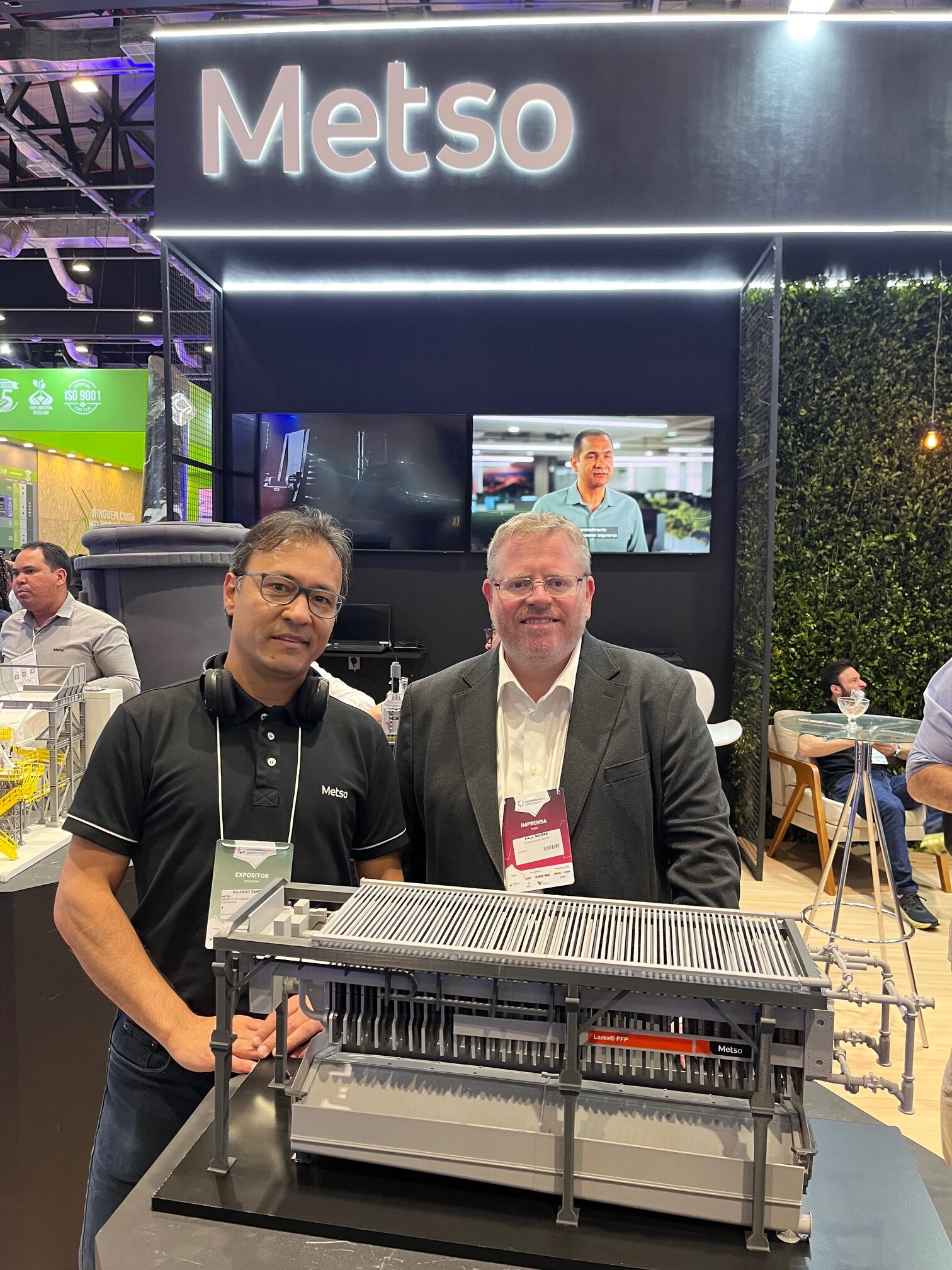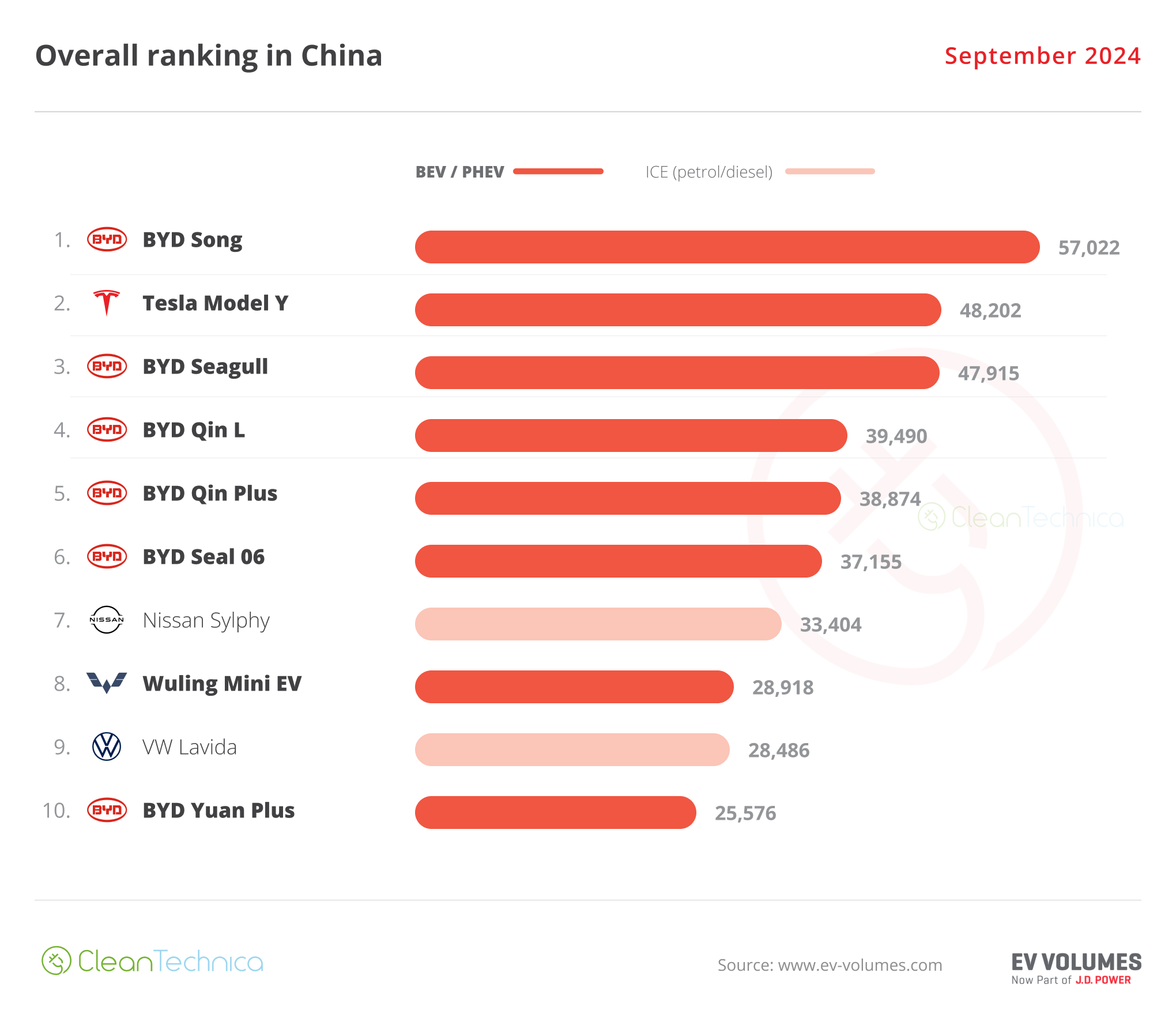Brazil is a hugely important market for the mineral processing majors, including Metso. IM Editorial Director Paul Moore had the chance to talk with Ricardo Takeda, Sales Director – Minerals for Brazil at Metso during the Exposibram 2025 event in Salvador; focusing on two booming markets – tailings filtration and compact iron ore crushing.
Brazil’s iron ore industry has been using tailings filtration for some years but there is now starting to be a big change in mindset which relates to the process requirements. Takeda told IM: “A lot of technologies and strategies have been used, including disc filters and belt filters, but these are mainly used for coarser tailings – the introduction of large vertical plate membrane filters we see as part of a big trend and one that will be a game changer in particular for dealing with tailings fines – slimes – in particular.”
Ricardo Takeda, Sales Director – Minerals for Brazil at Metso with Paul Moore, IM Editorial Director, at Exposibram 2025 with a model of the Metso Larox® FFP filter press

Today, companies are focusing on filtering coarser tailings; while others are combining coarse and fine tailings prior to filtration. Going forward, as the proportion of fines goes up, the tailings will become much harder to dewater to required moisture levels using disc filters for example – so Metso definitely sees a new era for large plate pressure filters coming in Brazil.
Takeda added: “The changes are also reflecting the mining reality – as mines are going deeper, grind size is decreasing to be able to liberate the iron ore – this is because many operations are exhausting or will exhaust their high-grade haematite reserves and going forward will mainly be processing lower-grade compact itabirite ores. Other mines are shifting from mining more easily crushed friable itabirite to compact itabirite.”
Another aspect to this is the move towards more premium pellet feed for DRI pellets. The steel industry wants premium, high grade DRI pellet feed to produce lower carbon steel using gas-based processes like flash smelting which require finer iron ore grinding and therefore results in more fines in the tailings.
Moving to the actual equipment, and recently Metso received its first order ever in Brazil for its large FFP filter presses in the iron ore tailings market. Two Metso Larox® FFP3512 filter presses are being deployed as part of a new tailings dewatering system with Minérios Itaúna Ltda (Minerita).
Takeda: “Minerita is a 54-year old family owned company with a very robust approach to new options and innovations so we are very pleased to be partnering with them. They are already filtering tailings using another technology but have chosen to work with us for this new project because of the reliability and performance that our FFP machines can deliver. It will be the first big reference for Metso in Brazil for large scale iron ore tailings; and we are confident this will just be the start as customers will see its potential to improve their operations. We do already have some FFPs dewatering bauxite waste – red mud – at Alunorte but these are the first in iron ore.”
There are also some competitors with plate filters already in Brazil but Metso is confident that the speed, advanced control system and high availability of the FFP will make a big difference in the market. “With large filter presses in tailings, a major factor in success is the cycle time because you are operating in batches plus you need to achieve the pressed moisture level that the customer needs for dry stacking. The FFP is a super modern filter with many features and technologies that make it very fast. To discharge the 98 large filter cakes from the FFP takes only 30 seconds – much faster than other equivalent filters in operation today. At Minerita, installation is well underway – the building is well advanced, along with a thickener in place, to be completed in Q1 2026.”
The Minerita filter press order led the discussion into another important part of iron ore mining innovation in Brazil – that is processing harder and more compact itabirite ores. The miner has also ordered from Metso all the major comminution equipment for its Compactos iron ore greenfield project, located in Itatiaiuçu, Minas Gerais, Brazil.
The aim with the new plant is to produce 4.5 Mt/y of high-grade premium pellet feed, in two phases. The more energy-efficient comminution circuit of the first phase will process compact itabirite iron ore and will consist of a Nordberg® C160™ jaw crusher, followed by a Nordberg® MP800 cone crusher, an HRCe™ HPGR and a 3.9 MW Select™ ball mill for primary grinding. The regrinding will be carried out with two Vertimill® mills VTM4500. The order for the Vertimill® mills was registered in the third quarter of 2025 from the Minerals area, and the other equipment in the first quarter of 2025.
A similar compact crushing plant has already been supplied to ArcelorMittal’s Serra Azul iron ore mine which was commissioned this year; it also handles compact itabirite ores as the friable material has been mined out. It includes three energy-efficient secondary comminution lines, each with a Metso VTM400 Vertimill® in combination with an HRCe™ HPGR, which are all preceded by a Superior™ MKIII 5065 primary crusher. The plant also uses Metso Nordberg ® HP400™ cone crushers plus large banana and horizontal screens. The plant will feed a new pellet production plant with high-quality ore that will integrate into ArcelorMittal’s global steel production network, with contracted supply to the group’s steel plants located in Mexico.
However, the largest compact crushing operation ever built in Brazil is underway at Vale’s S11D mine – this will have a huge 50 Mt/y capacity and is costing Vale some US$755 million to build. In its recent September 2025 Minas Gerais analyst tour, Vale stated that this is still on track to open in Q2 2026. It will handle some run of mine ore, but will mainly process huge waste piles of ore containing hard jaspilite, which has always represented a challenge at S11D. Jaspilite is a hard rock from the Carajas formation containing bands of jasper and iron minerals with 42% average Fe and 36% average SiO2. It is challenging due to its high abrasiveness and compressive strength.
Vale’s new compact crushing plant at S11D will allow it to process iron ore with hard jaspilite

According to Vale, it is a 60 m high structure with 84° inclination, with more than 5,000 t of steel applied. It has a deep foundation with 583 piles and has involved a huge logistical exercise with more than 17,000 trucks received, with peaks of 100/day. The project uses an adapted version of Maccaferri’s Green Terramesh®, with UV microgrid and a structure resistant to abrasion, salt spray, sun exposure and oxidation. All of this is designed to withstand intense traffic of mining trucks and also ensure safety and durability — with an estimated geogrid lifespan of 120 years.
The Vale Q3 2025 production report says that the compact crushing project has reached 83% completion. Metso is the major equipment supplier to the project, including the primary gyratory and two large apron feeders. Other companies involved include civil engineering firm Construtora Barbosa Mello; MCA Auditoria e Gerenciamento, which specialises in consulting, auditing and project management and construction; engineering services group AtkinsRéalis; and project management company Verum Partners.
Takeda told IM: “Jaspilite in the past has had to be considered as a sterile material and has been stockpiled as it could not be processed efficiently. Vale invested significant resources to come up with a solution for jaspilite. Thanks to the new compact crushing plant, it will now be processed in parallel with the main run of mine material which will mainly use the existing plant. The jaspilite ore will be crushed and classified and then blended with high grade ROM ore to create a new product. This means also avoiding all the costs previously incurred to transport and dump the jaspilite material.”
Metso has supplied its largest ever gyratory delivered in Brazil for the compact crushing plant – a Superior™ MKIII 70-89 – it is capable of 15,000 t/h and has a 1,780 mm feed opening, power rating of 900 kW and weighs 430 t. It is the same diameter as the MKIII 60-89 but taller. Metso has also supplied the outstanding largest ever apron feeders delivered in Brazil, that feeds the crusher plus a second apron feeder for the discharge, plus a series of banana screens.
Upstream, for ROM ore, Metso has also supplied three large FIT™ stations which act as secondary crushing buffers between the three main truckless primary mining systems that were originally supplied by Sandvik Mining Systems but are now maintained by FLS after its acquisition of the majority of Sandvik Mining Systems in 2017.
Takeda: “The three FIT™ stations are effectively very large modularised secondary crushing plants to enable a better control of the particle size distribution of the material coming from the primary mining system ABON sizers. These plants sit between the three mining systems and the main long distance overland conveyor. They have recently been commissioned and are running – each station contains one large Metso GP500 Nordberg® cone. With our FIT™ station we were selected as we could engineer a very modularised and compact solution to allow their positioning in a relatively tight space. Our cones are able to supply a very consistent particle size to the conveyor whereas in the past there has often been larger slabs of material reaching the conveyor which can be more difficult to handle.”
The FIT™ stations were pre-assembled close to their final working position and both Metso and Vale worked with MILPLAN Engenharia, who carried out the construction and then another company transported them into position using SPMTs. The three stations match the 11,500 t/h capacity of the mining systems. Metso now has five FIT™ stations working at Vale operations – with the first two built in 2024 at the Serra Norte mine, which is part of the Carajás complex. These recrush oversize material at the end of the process, reducing the transport distance within the mine. Before them, material with above-standard particle size was transported via off-highway trucks to other crushing units.
Takeda concluded: “FIT™ stations are really seeing a lot of growth for us in Brazil now – they are really getting noticed as they are modular so you can have a complete crushing station, even up to large primary crushing stations, engineered, constructed and delivered relatively quickly. Not using concrete or only small concrete construction support by reducing the implementation cost a lot.”




